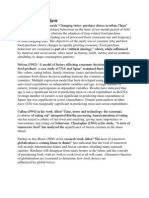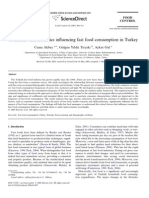ojsadmin,+OzdemirH 11
ojsadmin,+OzdemirH 11
Uploaded by
20uco648Copyright:
Available Formats
ojsadmin,+OzdemirH 11
ojsadmin,+OzdemirH 11
Uploaded by
20uco648Original Title
Copyright
Available Formats
Share this document
Did you find this document useful?
Is this content inappropriate?
Copyright:
Available Formats
ojsadmin,+OzdemirH 11
ojsadmin,+OzdemirH 11
Uploaded by
20uco648Copyright:
Available Formats
Consumer Preferences for Fast Food Brands: Evidence from an Emerging
Country
Handan OZDEMIR
Cankaya University
Elif AKAGUN ERGIN
Cankaya University
Amid the economic problems and health concerns, there has been a rapid growth in the fast food industry
in Turkey, with 3,453 restaurants currently serving the market. Fast food consumption is more popular
among children and teenagers making. Turkey a very lucrative market, since almost half of the countrys
73 million population is under the age of 25.The aim of this research is to explore young consumers
overall behavior toward fast food chains. More specifically, the purpose here is to identify the key factors
that influence these young consumers preferences of local and international brands of fast food
restaurants. A total of 400 students were recruited from two public and two private universities. Results
of factor analysis suggest five dominant factors that have an impact on young consumers preferences of
different brands of fast food restaurants. These factors include brand name reputation, cost,convenience,
consistency and quality. Moreover, it is observed that these five factors are significantly related to several
demographic variables such as age, gender, income level.Results of this study emphasize the importance
of the dominant factors that young consumers consider as critical when they compare various fast food
brands and make a final purchase decision.
INTRODUCTION
Fast food has gone global, with McDonalds alone serving 46 million people worldwide each day
(Spurlock 2005). Of the five new McDonalds opened each day, four of those restaurants open outside of
the United States (Schlosser 2001). The increasing consumption of fast food is an international trend
influenced by changing lifestyles (Belasco and Scranton 2002).
Fast food restaurants are typically distinguished by several major characteristics. There is a
standardized menu, portions and ingredients are tightly controlled, and the food is for immediate
consumption. In addition, there is a young and unskilled labor force serving at the counter and for chain
fast food restaurants, chained and franchised operations operate under a uniform structure and corporate
identity.
Journal of Marketing Development and Competitiveness Vol. 11(3) 2017 109
LITERATURE REVIEW
From the beginning of the 1980s, a huge number of publications have been published on fast food
industry in general. The early publications on fast food focused more on the positive and negative aspects
of fast food and the overall attitudes of the customers demanding fast food. The most frequent consumers
of fast foods are reported to be people in their teens and twenties (Lee 2007).
In two separate studies by Driskell et al. (2005) and Nickolas et al. (2001), it has been stated that
college students frequently consume fast foods. Eating at fast food restaurants appears to be part of the
normal routine during the daily lives of college students (Driskell et al. 2006). Several studies have been
conducted on reasons why college students prefer to eat at fast-food restaurants. These reasons include
menu choices, cost, convenience (Sneed and Holdt 1991), taste, socializing with friends, a chance to get
out (Hertzler and Frary 1996), advertisement, and location (Driskell et al 2006). It has also been
mentioned that some of the major reasons given by college men for their eating patterns are somewhat
different than those of college women (Driskell et al. 2006). Lee and Kim (2005) investigated college
students fast food consumption and preference in Korea, and reported that their selection of fast food was
affected mostly by friends and then by mass communication. They preferred hamburgers and pizza
among the menus.Kim and Kim (2004) examined college students behaviors on the fast food restaurants
within the Taejon area of Korea, and reported that college students eat fast food one to three times a
month with female students showing a higher frequency of visiting fast food restaurants than males.
Driskell et al (2006) reported that college students eat meals at fast food restaurants 6 to 8 times on a
weekly basis. Therefore, it is possible to claim that foods eaten at fast-food restaurants do substantially
contribute to the nutrient intakes of college students. Unfortunately, dietary intakes of most college
students fail to meet recommendations for most of the food groups (Dinger and Waigandt 1997). The
typical college student diet is high in fat and sodium and low in fruits and vegetables (Dinger 1999). In
addition, a study by Liedman et al. (2001) confirmed that college men consume more high-energy and
high-fat foods than women.
Obesity has been associated with fast-food consumption as well (Satia et al. 2004). The proliferation
of fast food restaurants is a predominant factor in sharp increases in obesity rates among children and
teenagers. The irony is that in most western countries, people are becoming increasingly more concerned
about health and fitness issues such as weight management, obesity prevention. Consumers seem to be
quite careful about the choices they make regarding their food purchases. However, in two separate
studies carried out by McCarthy et al. (2007) and Röhr et al. (2005), it has been stated that young
consumers in particular, still have inadequate food safety knowledge and may end up making poor
choices. Most of these young consumers, teenagers, college students still frequent the fast food
restaurants on a regular basis.
Similar to the rest of the developed world, Turkish fast food market continues its accelerated growth.
Major changes in the life styles, income levels, social structure and consumption patterns of Turks in the
last decade means they are increasingly prone to eat meals and socialize over food outside of the home.
The rapid increase in the number of shopping malls and hypermarkets across the country has led to an
emerging demand for the growing number of fast food chains and restaurants. There are currently 3,453
fast food outlets present in Turkey (Euro Monitor International 2010). 75% of them are located in big
cities like Istanbul, Ankara and Izmir. A new and faster pace of life in these urban areas has led people to
find quicker meal solutions for their daily needs. In addition, the western influence in the country enables
branded foreign products do well in the Turkish market.
Fast food was the only category in Turkish consumer foodservice that registered positive growth in
2009, following the economic crisis. The general view of market experts is that fast food will continue to
be a dynamic category due to lower prices when compared to other foodservice outlets and the speed of
service offered. The fast food market segmentation primarily includes chicken, burger, bakery products
and Middle Eastern fast food. It has been stated by many research studies, mentioned above in the
literature review, that fast food consumption is more popular among children and young consumers. This
110 Journal of Marketing Development and Competitiveness Vol. 11(3) 2017
makes Turkey a very lucrative market since nearly half of the countrys 73 million population is under the
age of 25.
The present study had two objectives. First, to identify the key factors that influence young
consumers preferences of local and international brands of fast food restaurants. Respondents were asked
to rank in importance the factors that have an impact on their preference of a fast food restaurant. We
asked the respondents whether they prefer fast food, why they prefer fast food, whether they are loyal to a
particular domestic/ international fast food restaurant, which restaurant they like most, and what they like
most about it.
In a similar vein, a number of studies have examined the demographic characteristics of those who eat
at fast-food restaurants (French et al. 2000; Bowman and Vinyard 2004). Results from these studies
indicate that those who are younger, employed and living in larger households are more likely to report
consuming fast food. In the second part of the study, we tested to see whether there is an association
between the demographic characteristics and the frequency of fast food consumption for our sample.
DATA AND METHODOLOGY
Sample
The sample for this study was 400 students that were recruited from two public and two private
universities in Ankara, the capital city of Turkey. Out of the twelve universities in Ankara, these four in
particular were selected by random sampling. Due to potential variations in income levels, stratified
random sampling was adopted and universities were classified as public and private. The study was
conducted during the spring months of 2016. The studys surveys were distributed during lunch hours at
the university cafeterias, and were conducted face-to-face. The students were asked to rank the major
attributes as decision criteria when choosing fast food restaurants.
Survey Instrument
The survey used in this study consisted of 4 parts, and a total of 43 questions. In the first part,
students were asked about their average fast food consumption frequency, their preferences for domestic
and/or international fast food brands. The second part of the survey included semantic differential scale
questions to determine the students overall attitude toward fast foods and different fast food restaurants.
In the third part, five-point Likert scale questions were used to measure the key factors that influence
college students preferences of local and international brands of fast food restaurants. The scale goes
from 1 (strongly disagree) to 5 (strongly agree). Finally, in the last part, questions were posed to
determine the demographic profile of the young consumers in the sample.The survey took about 10
minutes to complete. Cronbachs alpha was calculated to test the reliability of the scale used in the
research. The Cronbachs alpha coefficient of 0.840 (sign: 0.000) indicated the scale to be highly reliable.
The study was two-fold by purpose. In the first part, factor analysis was carried out to identify the
independent variables of the research. Furthermore, semantic differential scales were adopted to obtain
the students overall attitude toward fast foods and different fast food restaurants. Pearson Coefficient of
Skewness formula was utilized to measure the SK value and the data obtained by the application of the
semantic differential scale was interpreted accordingly (Freund and Simon 1997).
To determine young consumers overall attitudes towards fast food consumption and fast food
restaurants, a 7-point semantic differential scale with 6 pairs of adjectives was used in the study. These
adjectives were in line with the main objective of the research and included; positive- negative, good -
bad, strong - weak, successful - unsuccessful, unreliable - reliable and indispensable-
dispensable.
Journal of Marketing Development and Competitiveness Vol. 11(3) 2017 111
Hypotheses
On the basis of the objectives and after reviewing the extensive literature, the following research
hypotheses were framed.
H1: Convenience, brand name reputation, cost, consistency and quality have a great influence on college
students brand preference among fast food restaurants.
H2: There is a significant difference between the frequency of fast food consumption and gender.
H3: There is a significant relationship between the frequency of fast food consumption and age.
H4: There is a significant relationship between the frequency of fast food consumption and income level.
RESULTS AND DISCUSSION
Table 1 displays the demographics of the research sample. As depicted below, the sample was evenly
dispersed between males (51.2 percent) and females (48.8 percent). The majority of the students in the
sample (79.2 percent) were between the ages of 17-24.
TABLE 1
DEMOGRAPHIC PROFILE OF THE SAMPLE
Age Groups Frequency %
17-20 116 29.0
21-24 201 50.2
25-28 83 20.8
Total 400 100.0
Gender
Female 195 48.8
Male 205 51.2
Total 400 100.0
Monthly Income Level
500-999 TL 45 11.2
1000-1499TL 54 13.5
1500-1999TL 172 43.0
2000-2499TL 56 14.0
2500 and over 73 18.2
Total 400 100.0
Table 2 shows the students average monthly frequency of fast food consumption. Nearly 40 percent
of the subjects indicated that they go out to eat at fast food restaurants at an average of 5-10 times a
month. 26.8 percent reported their average monthly fast food consumption as more than ten times a
month. Only 14.8 percent of the students in the study mentioned that they prefer to eat fast food once a
month.
112 Journal of Marketing Development and Competitiveness Vol. 11(3) 2017
TABLE 2
AVERAGE MONTHLY FREQUENCY OF FAST FOOD CONSUMPTION
Average monthly Frequency Percent
Fast food consumption
Once a month 59 14.8
2-4 times a month 75 18.8
5-10 times a month 159 39.8
More than 10 times a month 107 26.8
Total 400 100.0
When fast food consumption patterns of these young consumers are examined, almost one out of
seven respondents stated that they prefer to eat at fast food restaurants when they go out. The remaining
31.8 percent said they opt to eat at other traditional/theme cuisine restaurants (Table 3).
TABLE 3
FREQUENCY OF PREFERENCE FOR FAST FOOD RESTAURANTS
When I opt to eat out; Frequency Percent
I prefer fast food restaurants 273 68.2
I prefer other food service outlets 127 31.8
Total 400 100.0
In a similar vein, Table 4 lists the frequency of preference for domestic and/or international branded
fast food restaurants. Results shown here suggest a majority of young consumers (70.5 percent) prefer to
patronage international brand fast food restaurants. This finding is consistent with the fact that there is a
western influence in Turkey, enabling foreign brands/ products to perform well in the Turkish market.
TABLE 4
FREQUENCY OF PREFERENCE FOR DOMESTIC/ INTERNATIONAL BRANDEDFAST
FOOD RESTAURANTS
When I opt to eat fast food; Frequency Percent
I prefer domestic brand restaurants 118 29.5
I prefer international brand restaurants 282 70.5
Total 400 100.0
Another noteworthy consumption pattern is portrayed in Table 5. 60 percent of the young consumers
in the sample claimed that they consume fast food as a complete meal whereas 39.2 percent classify it as a
snack.
Journal of Marketing Development and Competitiveness Vol. 11(3) 2017 113
TABLE 5
CATEGORIZATION OF FAST FOOD CONSUMPTION
Frequency Percent
I consume fast food as a;
Meal 243 60.8
Snack 157 39.2
Total 400 100.0
Table 6 presents the various location alternatives where respondents prefer to consume fast food
products. More than half of the subjects (64,5%) have identified food courts of malls as the place where
they mostly consume fast food.
TABLE 6
LOCATION OF FAST FOOD CONSUMPTION
I consume fast food at; Frequency Percent
School Cafeteria 80 20.0
Home 61 15.2
Food Courts of Malls/ Stores 259 64.8
Total 400 100.0
TABLE 7
MOST POPULAR AND PREFERRED FAST FOOD RESTAURANTS
Brand Name Frequency Percent
Burger King 178 44.5
McDonalds 172 43.0
Hosta 166 41.5
SimitSaray 155 38.8
Dominos Pizza 148 37.0
OtantikKumpir 132 33.0
KFC 124 31.0
Pizza Hut 122 30.5
Aba Piknik 98 24.5
Popeyes 68 17.0
Table 7 and Table 8 list the top ten fast food restaurants and categories that were reported to be highly
popular and mostly preferred by the young consumers in the sample. The top two spots were shared by
global fast food giants Burger King and McDonalds. The third place belonged to Hosta, which is a
Turkish fast food restaurant chain specializing in meat and chicken döner (meat rotating on a grill). Simit,
a salty, sesame doughnut, is another highly popular fast food among Turkish consumers and came in
fourth position in the ranking. Also included in the top ten were OtantikKumpir (a fast food restaurant
specializing in baked potato dishes), and KFC & Popeye along with pizza chains Dominos & Pizza Hut.
114 Journal of Marketing Development and Competitiveness Vol. 11(3) 2017
TABLE 8
CONSUMPTION FREQUENCY OF FAST FOOD CATEGORIES
Fast Food Categories Frequency Percent
Hamburger- French Fries 199 49.8
Döner (Meat rotating on a stick) 180 45.0
Simit (Sesame doughnut) 150 35.5
Pizza 136 34.0
Kumpir (Baked Potato) 125 31.2
Köfte (Meatballs) 99 24.8
Table 9 indicates the results of the semantic differential scale that was applied to determine young
consumers overall attitudes towards fast food consumption and fast food restaurants. The means and
standard-deviation values for each of the 6 pairs of adjectives (A1: positive- negative, A2: good - bad,
A3: strong - weak, A4: successful - unsuccessful, A5: reliable - unreliable and A6: dispensable
indispensable) are presented.
TABLE 9
YOUNG CONSUMERS OVERALL ATTITUDE TOWARDS FAST FOOD AND FAST FOOD
RESTAURANTS
The scale analysis revealed young consumers possessed an overall positive attitude toward different
fast food categories ( X =5.18). In a similar vein, a mean value of 5.01 signified young consumers
belief that fast food is strong compared to other traditional food types/dishes. Moreover, young
consumers stated that fast food is reliable and successful in general. Perhaps the most prominent finding
in attitudes is, young consumers statement that fast food is indispensable for them ( X =6.35).
Journal of Marketing Development and Competitiveness Vol. 11(3) 2017 115
TABLE 10
YOUNG CONSUMERS OVERALL ATTITUDE TOWARDS FAST FOOD CATEGORIES AND
FAST FOOD RESTAURANTS
Negative 5.34 6.03 Positive
Good
Bad 5.26 5.18
Strong
Weak 5.12 5.01
Successful
Unsuccessful 5.36 5.86
Reliable
Unreliable 4.3 5.24
Dispensable 5.93 6.35 Indispensable
Fast Food
Fast Food
1 2 3 4 5 6 7 Restaurants
Table 10 also depicts young consumers overall attitude towards fast food restaurants. Parallel to
attitude towards fast food categories, consumers in the sample declared a positive attitude to fast food
restaurants as well ( X =5.34). In addition, fast food restaurants were deemed to be good, strong and
successful. However, respondents in the study were indecisive about the reliability of the fast food
restaurants ( X =4.30). Nonetheless, the overall attitude signified fast food restaurants to be indispensable
( X =5.93).
Data Analysis
In this empirical study, an application of factor analysis will be explored to identify the major factors
that influence young consumers brand preferences of fast food restaurants. Prior to factor analysis,
construct validity analysis was done to determine the relationship among the variables and to check
whether the sample was suitable for factor analysis. Kaiser-Meyer-Olkin value was measured as 0.911.
Based on this value, it can be concluded that the sample has a good fit for factor analysis. Bartletts test of
Sphericity (chi square: 3.557 sig: 0.000) has proven the existence of a general relationship between the
variables.
116 Journal of Marketing Development and Competitiveness Vol. 11(3) 2017
Factor analysis is a set of techniques for determining the extent to which variables that are related can
be grouped together so that they can be treated as one combined variable or factor rather than as a series
of separate variables. Factor analysis is often used in the empirical research in social sciences (Hatcher,
1994). The most common use of factor analysis in the social and behavioral sciences is to determine
whether the responses to a set of items used to measure a particular concept can be grouped together to
form an overall index of that concept (Duncan, 2003).
The objective here was to obtain fewer dimensions that reflected the relationships among the inter-
related variables. The eigenvalue greater than one rule was applied in identifying the number of factors.
The variables that had large loadings on the same factors were grouped. Initially there were eight scaled
variables that were measured. After factor analysis, three of these variables were deleted, and five factors
were created. These factors are: F1: Convenience, F2: Brand Name Reputation, F3: Cost, F4:
Consistency, F5: Quality. The cumulative percent of variance explained was 67.795. Convenience had the
highest impact on fast food store preference ( = 0.293) and the factor with the lowest impact was quality
( = 0.143). These five-factors with respective loading levels are presented in Table 11 below.
Factor 1: Convenience
The primary factor that has been identified is convenience. This factor accounts for 18.161 percent
of the total variance and consists of seven statements. (Q9: Fast food saves a lot of time for me, Q11: I
prefer going to fast food restaurants due to their proximity, Q12: Fast food simplifies my life, Q23: Fast
food is easy to get to, Q28: Fast food restaurants are open until late at night, Q6: Fast food is quickly
prepared, Q1: Fast food is very practical). An assessment of factor loadings reveals that the major factor
influencing the consumption is time. Young consumers stated that fast food saves a lot of time for them
since they are always in a hurry, with a lack of time. Taste used to be the traditional element to influence
consumers eating choices (Glanz, Basil & Mailbach 1998). However, with the fundamental changes in
the lifestyles, the emphasis on convenience has greatly increased. Consumers prefer fast food restaurants
due to their easy to access locations, speed of service, flexibility. In the daily routine of juggling hectic
schedules, fast food reduces the amount of work consumers have to do and saves time.
Factor 2: Brand Name Reputation
The second extracted factor that is able to explain % 15.852 of the total variation is brand name
reputation. This factor indicates that young consumers place an emphasis on the brand name and its
associations. For many respondents, strong, popular global brands of fast food restaurants were favored
more in certain aspects such as quality, trust. There are five variables in the composition of this particular
factor. (Q2: A global fast food brand is trustworthy in every aspect, Q27: I prefer not to eat at unfamiliar
brands of fast food restaurants, Q26: A global fast food brand provides better quality food, Q10: A
popular branded fast food restaurant has a positive effect on my consumption, Q14: It is important to be a
strong, well-known brand in the fast food industry). It is evident that strong brand name recognition is a
major advantage for fast food restaurants.
Factor 3: Cost
The third factor signifies the cost element. This factor accounts for 15.013 percent of the total
variation. The cost factor is reflected via these four statements. (Q15: Fast food is inexpensive, Q16: Fast
food is a cheaper option compared to alternative food outlets, Q20: I get good value for my money, Q24:
Get two meals for the price of one promotions increase my fast food consumption). Young consumers,
being students on a limited budget, state that the cost of a meal is an important factor that influences their
fast food restaurant preference. Going out for cheap eats is an obvious way for young consumers to keep
their spending in check. That is why fast-food restaurants are seen as a good investment from their
perspective. Those restaurants that provide bigger and better options at low prices are considered as
attractive alternatives.
Journal of Marketing Development and Competitiveness Vol. 11(3) 2017 117
TABLE 11
FACTOR LOADINGS AND TOTAL VARIANCE LEVELS
Factor % of
Loads Variance
Factor 1: Convenience 18.161
Fast food saves a lot of time for me. 0.684
I prefer going to fast food restaurants due to their proximity. 0.678
Fast food simplifies my life. 0.663
Fast food is easy to get to. 0.574
Fast food restaurants are open until late at night. 0.543
Fast food is quickly prepared. 0.512
Fast food is very practical. 0.510
15.852
Factor 2: Brand Name Reputation
0.816
A global fast food brand is trustworthy in every aspect 0.777
I prefer not to eat at unfamiliar brands of fast food restaurants 0.724
A global fast food brand provides better quality food 0.673
A popular branded fast food restaurant has a positive effect on 0.602
my consumption
It is important to be a strong, well-known brand in the fast food
industry
15.013
Factor 3: Cost
0.896
Fast food is inexpensive. 0.881
Fast food is a cheaper option compared to alternative food 0.793
outlets. 0.754
I get good value for my money.
Get two meals for the price of one promotions increase my
fast food consumption.
9.908
Factor 4: Consistency
0.841
I feel safe knowing that a global fast food restaurant serves a
consistent menu with a consistent taste in every branch it 0.727
operates. 0.462
I prefer global fast food restaurants due to the standard,
consistent menus they serve. 0.406
The standard, consistent menus at global fast food restaurants
increase my overall fast food consumption.
Every branch of global branded fast food restaurant has
consistent service ability.
8.861
Factor 5: Quality
0.756
Global branded fast food restaurants are higher in quality. 0.713
Global branded fast food restaurants use high quality 0.634
ingredients in their meals.
Global branded fast food restaurants are more reliable.
118 Journal of Marketing Development and Competitiveness Vol. 11(3) 2017
Factor 4: Consistency
The fourth extracted factor pays attention to consistency and is able to explain 9.908 percent of the
cumulative variance. Fast food restaurants accomplish their consistency by creating a formula for their
products. That formula is expressed as the ingredients that are used, the assembly line created to put those
ingredients together, and the training given to the individuals to work the assembly line. The availability
of standardized menus, fast and courteous service in different locations of global branded fast food chain
restaurants signifies consistency for the consumers. This increases the predictability and satisfaction for
their fast food consumption experience. No matter what part of the world they travel, they are familiar
with the fast, reliable and efficient service and the type of food that is offered at these fast food outlets.
Service consistency is an expectation of all customers at all times; they want peace of mind and no
unpleasant surprises. Young consumers, in particular, are willing to give up the possibility of some higher
quality foods in favor of knowing they will get a consistent experience. They are on the lookout for
something that is quick and predictable so that they can get on with their day. This is the fundamental
thinking of fast food, fast and consistent.
Factor 5: Quality
The factor with the lowest impact is quality. It accounts for 8.861 percent of the cumulative
variance. There are three variables in the composition of this last factor. (Q17: Global branded fast food
restaurants are higher in quality, Q21: Global branded fast food restaurants use high quality ingredients in
their meals, Q7: Global branded fast food restaurants are more reliable). The operations of global fast
food chains follow a host of dietary and marketing rules set by various cultures and governments around
the world. Young consumers seem to possess this information and it affects their fast food restaurant
preferences. They believe that these global brands have higher quality standards, do more research, use
high quality ingredients and work more on delivering healthier meals.
Hypothesis Testing
With the main hypothesis H1, we explored the influence of five factors (convenience, brand name
reputation, cost, consistency and quality) on young consumers brand preferences among fast food
restaurants. Multi-regression analysis was conducted to assess the effect of these five particular factors.
The analysis signified that these five factors effect on the brand preferences for fast food restaurants was
statistically significant (sig = 0.000). Thus, H1 was accepted.
The regression value (R= 0.826) indicated that there is a strong, positive relationship among the five
variables. It was concluded that convenience, brand name reputation, cost, consistency and quality
account for 68 percent of the variation in young consumers preference for different brands of fast food
restaurants (R2 = 0.68). According to standardized beta coefficients, the five independent variables can be
listed as convenience ( =0.293); brand name reputation ( =0.249); cost ( =0.213), consistency (
=0.180), and quality ( =0.143).
The second hypothesis of this study investigated a possible relationship between the frequency of
young consumers fast food consumption and gender factor. To evaluate this hypothesis, t-test analysis
was carried out. Based on Levenes test result, variances among groups were observed equal (F=2.064
p=0.152). Equal variances assumed value holds (sign 0.001<0.05) therefore, H2 is accepted. It is found
that gender does have an impact on the frequency of fast food consumption. The group statistics presented
below on Table 13 signifies that boys ( X = 3.93) consume more fast food than girls ( X =3.16).
The third hypothesis explored the relationship between the frequency of fast food consumption and
age. The correlation analysis suggested that age factor had no significance over a consumers fast food
consumption frequency (sign 0,156>0,05), thus H3 was not supported. The last hypothesis of the study
was developed to test for the effect of income level on fast food consumption frequency. By contrast to
H3, the correlation analysis on H4 signified a strong, positive relationship between these two variables
(p=0,000<0,05). It was concluded that higher income consumers patronize fast food restaurants more
frequently. This finding tends to disagree with some research studies conducted in the United States that
Journal of Marketing Development and Competitiveness Vol. 11(3) 2017 119
lower income consumers consume more fast food. However, a possible explanation could be that in
relative economic terms, meals at fast food restaurants cost more in Turkey.
CONCLUSION
The changes prompted by fast food have taken place very quickly and have been so all-encompassing
for consumers around the globe. The same can be said for Turkish consumers and the rapid penetration of
fast food industry in the country. The objective of this research was to explore the main factors that
influence young consumers preferences of local and international brands of fast food restaurants in
Turkey. Factor analysis and semantic differential scales were used for this investigation. Five underlying
factors were identified as being influential in the brand preferences of these young consumers fast food
consumption. These factors were convenience, brand name reputation, cost, consistency and quality.
The findings of the study revealed that the most important attribute in fast food restaurant selection
was convenience. Furthermore, the study indicated that young consumers were heavily influenced by the
convenience and consistency elements of fast food restaurants. The brands reputation was also reported
to be a prominent factor in their restaurant selection. All categories of fast food restaurants were
mentioned in the top ten, including McDonalds & Burger King (burger & fries) to Hosta & Aba Piknik
(döner-meat on a stick grill), to Dominos & Pizza Hut (pizza) and KFC & Popeyes (chicken). Even
though these young consumers reported to be fond of the burger and French fries at well-known global
brands such as Burger King, they also demanded traditional Turkish fast food providers such as Hosta for
döner, Simit Sarayi for sesame doughnuts and Otantik Kumpir for baked potatoes. Cost and quality
attributes were also signified in the results of the study. College students are money-sensitive since they
live on limited budgets, and do not have full-time jobs. They would like to get quick, high quality fast
food meals at affordable prices with a consistent taste and service level. The results from this study also
suggested even though gender had an impact on the frequency of fast food consumption, age had no
significance. Lastly, income level was reported to be significantly correlated with fast food consumption
frequency.
The results provide useful information not only to domestic and but also to foreign fast food retailers.
International fast food restaurant chains coming to Turkey and planning to target youth segments will
better understand their consumers perceptions and preferences.
LIMITATIONS
Several factors limit the generalizability of results from this study. First, the study took place in the
three biggest cities of Turkey. The young consumers in the sample, college students in particular, live in
these urban, well-developed cities. It is highly likely that these consumers have a different social, cultural
and/or economic profile when compared to their peers from smaller cities, towns in rural parts of
Anatolia. The proliferation of fast food restaurants, especially global branded chains, is much greater in
urban cities throughout the country. It remains to be seen whether there are sharp similarities and
differences in the fast food restaurant preferences of young consumers from other parts of Turkey. In
many smaller cities and towns, global branded chains are not available, therefore major national/local fast
food outlets are preferred. Further research is needed regarding this subject matter. Second, in this study,
we could not consider all of the social, economic and cultural variables that might affect the relationship
between young consumers and their fast food restaurant preferences. Other than the reported five main
determinant factors here, there may be additional motivators that cause young consumers to favor specific
fast food restaurants. Third, the study involved the viewpoint of young consumers attending college. The
research issue could be expanded to see the view of a general population to determine if these findings are
confined to the college student group, or if they may be common to the general public in Turkey.
For these reasons, extreme caution in generalizing these results to any population beyond the study
sample is warranted. Future research employing different sampling techniques and involving a larger
sample size might yield results that are significantly distinct from those reported in this study. Despite
120 Journal of Marketing Development and Competitiveness Vol. 11(3) 2017
these limitations, our research contributes an overview of the main factors that play critical role in
shaping young, urban Turkish consumers fast food restaurant choices. Consistent with the previous
research studies, our findings highlighted overlapping areas between fast food preferences of young
consumers in Turkey to those of their peers around the world.
REFERENCES
Belasco, W J, Scranton, P (2002) Food Nations: Selling Taste in Consumer Societies, Routledge, New
York, NY.
Bowman, SA, Vinyard, BT (2004) Fast Food Consumption of US Adults: Impact on Energy and
Nutrient Intakes and Overweight Status. Journal of American College of Nutrition, vol. 23, p.
163-168.
Dinger, MK (1999) Physical Activity and Dietary Intake among College Students. American Journal of
Health Studies, vol. 15, p. 139-149
Dinger, MK, Waigandt, A (1997) Dietary Intake and Physical Activity Behaviors of Male and Female
College Students. American Journal of Health Promotion, vol. 11, p. 360-362.
Driskell, JA, Meckna BR, Scales NE (2006) Differences Exist in the Eating Habits of University Men
and Women at Fast-Food Restaurants. Nutrition Research, vol. 26, p. 524-530.
Driskell, JA, Kim YN, Goebel KJ (2005) Few Differences Found in the Typical Eating and Physical
Activity Habits of Lower-Level and Upper-Level University Students. Journal of American Diet
Association, vol. 105, p. 798-801.
Duncan, C (2003)Advanced Quantitative Data Analysis. 1st Edition, McGraw-Hill Education,
Berkshire.
Euro Monitor International (2010) Fast Food in Turkey Report. URL http://www.euromonitor.com/fast-
food-in-turkey/report (accessed on May 4th, 2011).
French, SA, Story, M, Neumark-Sztainer, D, Fulkerson, JA, Hannan P (2001) Fast Food Restaurant Use
among Adolescents: Association with Nutrient Intake, Food Choices and Behavioral and
Psychosocial Variables. International Journal of Obesity Related Metabolic Disorders, vol. 25,
p. 1823-1833.
French, SA, Harnack, LJ, Jeffery, RW (2000) Fast Food Restaurant Use among Women in the Pound of
Prevention Study: Dietary, Behavioral and Demographic Correlates. International Journal of
Obesity, vol. 24, p. 1353-1359.
Freund, E John, Simon, A Gary (1997) Modern Elementary Statistics (9th Edition), Prentice Hall, New
Jersey.
Galore, SR, Walker, C, Chandler, A (1993) Brief Communication: Dietary Habits of First-Year Medical
Students as
Determined by Computer Software Analysis of Three-Day Food Records. Journal of American College
of Nutrition, vol. 12, p. 517-520.
Glanz, K., Basil, M., Mailbach, E., et al. (1998) Why Americans Eat What They Do: Taste, Nutrition,
Cost, Convenience and Weight Control Concerns as Influences on Food Consumption. Journal
of the American Dietetic Association, vol. 98(10), p. 11181126.
Hatcher, Larry (1994) A Step-by-Step Approach to Using the SAS System for Factor Analysis and
Structural Equation Modeling. The SAS Institute, Cary, NC.
Hertzler, A.A, Frary RB (1996) Family Factors and Fat Consumption of College Students.Journal of
American Diet Association, vol. 96, p. 711-714.
Kim KW, Ahn Y, Kim HM (2004) Fast Food Consumption and Related Factors among University
Students in Daejeon. Korean J Community Nutrition, vol. 9, p. 4757.
Kim, H.Y, Choi, S.H, Ju, S.E (1996) A Survey of the Behaviors on Fast Food Restaurants.Korean
Journal of Dietary Culture, vol. 11 (1), p. 7182.
Lee, J S (2007) A Comparative Study on Fast Food Consumption Patterns Classified by Age in Busan.
Korean Journal of Community Nutrition, vol. 12, p. 534-544.
Journal of Marketing Development and Competitiveness Vol. 11(3) 2017 121
Liedman, M, Cameron, BA, Carson, DK, Brown, DM, Meyer, SS (2001) Dietary Fat Reduction
Behaviors in College Students: Relationship to Dieting Status, Gender and Key Psychosocial
Variables. Appetite, vol. 36, p. 51-56.
McCarthy, M, Brennan, M, Kelly, A.L, Ritson, CB, & Thompson, N. (2007) Who is at Risk and What
Do They Know? Segmenting A Population on Their Food Safety Knowledge. Food Quality and
Preference, vol. 18(2), p. 205-217.
Nickolas, TA, Baranowki T, Cullen KW, Berenson G (2001) Eating Patterns, Dietary Quality and
Obesity. Journal of the American College of Nutrition, vol. 20, p. 599-608.
Rohr, A, Luddecke, K, Drusch, S, Muller, MJ, & Alvensleben, Rv (2005) Food Quality and Safety
Consumer Perception and Public Health Concern. Food Control, vol. 16, p. 649-655.
Satia, JA, Galanko, JA, Siega-Riz, AM (2004) Eating at Fast Food Restaurants is Associated with
Dietary Intake, Demographic, Psychosocial and Behavioral Factors among African-Americans in
North Carolina. Public Health Nutrition,vol. 7, p. 1089-1096.
Schlosser, E (2001) Fast food nation: The Dark Side of the All-American Meal. Houghton Mifflin,
Boston.
Sneed J, Holdt CS (1991) Many Factors Influence College Students' Eating Patterns. Journal of
American Diet Association, vol. 91, p. 1380.
Spurlock, M (2005) Dont Eat This Book: Fast food and the Supersizing of America. GP Putnams
Sons, New York.
122 Journal of Marketing Development and Competitiveness Vol. 11(3) 2017
You might also like
- 5k SSNDocument309 pages5k SSNNehal Jabed50% (4)
- Manners For KidsDocument20 pagesManners For KidsEliza Man100% (1)
- CHAPTER 4and5Document29 pagesCHAPTER 4and5Joseph Sulpicio Cadorna100% (6)
- Castes in PunjabDocument363 pagesCastes in PunjabElectrical-Engineer100% (2)
- Factors Influencing Young Consumer Preferences of Domestic and International Fast Food BrandsDocument21 pagesFactors Influencing Young Consumer Preferences of Domestic and International Fast Food Brandsapi-378570432No ratings yet
- Analysing Malaysian Students Attitude Towards Fast Food Health EssayDocument6 pagesAnalysing Malaysian Students Attitude Towards Fast Food Health EssayNiveditha Rajan0% (1)
- Review of Related LiteratureDocument4 pagesReview of Related LiteratureHilda Joyce RonielNo ratings yet
- Fast Food ConsumptionDocument6 pagesFast Food ConsumptionAash KhanNo ratings yet
- The Impacts of Fast Food Consumption To The Students of MISTDocument14 pagesThe Impacts of Fast Food Consumption To The Students of MISTJonela LazaroNo ratings yet
- Fast Food Habit Among UUMDocument10 pagesFast Food Habit Among UUMbizcootNo ratings yet
- Consumer Perception and Preference of Fast Food: A Study of Tertiary Students in GhanaDocument7 pagesConsumer Perception and Preference of Fast Food: A Study of Tertiary Students in GhanaBella Monica Montecino0% (1)
- A Study On The Perception of Youth Towards Fast Food: Dr. Veni Nair, Dr. Sarit Prava Das AbstractDocument9 pagesA Study On The Perception of Youth Towards Fast Food: Dr. Veni Nair, Dr. Sarit Prava Das AbstractAnisha AmmuNo ratings yet
- Chapter 1 1Document9 pagesChapter 1 1Janine BordarioNo ratings yet
- Running Head: Business Research and Report Writing 1Document7 pagesRunning Head: Business Research and Report Writing 1KENNo ratings yet
- SSRN Id2502101 PDFDocument20 pagesSSRN Id2502101 PDFMoni SaranNo ratings yet
- IntroductionDocument11 pagesIntroductionSatender SinghNo ratings yet
- Factors That Affect Fast Food Consumption - A Review of The LiteraDocument16 pagesFactors That Affect Fast Food Consumption - A Review of The LiteraJannah AlcaideNo ratings yet
- The Problem Background of The StudyDocument36 pagesThe Problem Background of The StudyMargo CTNo ratings yet
- Food Habits and Nutrient Intake of Bankers in Lagos StateDocument3 pagesFood Habits and Nutrient Intake of Bankers in Lagos StateIOSRjournalNo ratings yet
- Review of Literature of Fast Food IndustryDocument5 pagesReview of Literature of Fast Food Industryanjali118763% (16)
- A StudyDocument12 pagesA StudyNichchanun LertnuwatNo ratings yet
- IJRPR2375Document5 pagesIJRPR2375luckyymickeyyNo ratings yet
- Awareness of Health Consequences of Junk Foods Among Medical StudentsDocument5 pagesAwareness of Health Consequences of Junk Foods Among Medical Studentsprincesspaypa21No ratings yet
- Trend of Fast Food Consumption and Its Effect On Pakistani SocietyDocument8 pagesTrend of Fast Food Consumption and Its Effect On Pakistani SocietyFarzan Yahya100% (1)
- Research On Consumer Perception and Behaviour Towards Fast FoodDocument3 pagesResearch On Consumer Perception and Behaviour Towards Fast FoodKunjal RambhiaNo ratings yet
- Impact of Fast Food On Human Health (Vanshita Rajput)Document6 pagesImpact of Fast Food On Human Health (Vanshita Rajput)VANSHITA RAJPUTNo ratings yet
- 3950 6002 1 PBDocument9 pages3950 6002 1 PBAhmed SaeedNo ratings yet
- Business Schools in Pakistan: Name of GroupDocument6 pagesBusiness Schools in Pakistan: Name of GroupNirmal RiaZNo ratings yet
- Studying Eating Habits Among Undergraduates College Student at Minia UniversityDocument24 pagesStudying Eating Habits Among Undergraduates College Student at Minia UniversityÁnh NguyễnNo ratings yet
- Food Sanitation Practices in A Private Education InstitutionDocument33 pagesFood Sanitation Practices in A Private Education InstitutionGwen De CastroNo ratings yet
- Consumer Perception On Nutritional Information in Restaurant MenuDocument9 pagesConsumer Perception On Nutritional Information in Restaurant MenuBella Monica MontecinoNo ratings yet
- Food Safety Knowledge, Attitude and Hygiene Practices Among The Street Food Vendors in Northern Kuching City, SarawakDocument9 pagesFood Safety Knowledge, Attitude and Hygiene Practices Among The Street Food Vendors in Northern Kuching City, SarawakFidya Ardiny50% (2)
- Ewc661 ProposalDocument30 pagesEwc661 ProposalHudal FirdausNo ratings yet
- Health Consciousness and Fast Foods - A Study Among College Students in Lunglei Town, MizoramDocument11 pagesHealth Consciousness and Fast Foods - A Study Among College Students in Lunglei Town, MizoramJoel DarlongNo ratings yet
- Literature Review of INDIA STUDYDocument7 pagesLiterature Review of INDIA STUDYRabia Malik100% (2)
- Consumer Behavior To Fast FoodDocument9 pagesConsumer Behavior To Fast FoodAl Amin0% (1)
- EBSCO Metadata 2024 04 15Document2 pagesEBSCO Metadata 2024 04 15Aicza LimachiNo ratings yet
- Group 3 -Impacts of Fast Food on Diet Among University Students 25.11Document6 pagesGroup 3 -Impacts of Fast Food on Diet Among University Students 25.11lehuyen.dhtlNo ratings yet
- Fast Food Consumption and Its Impact On Health: ArticleDocument10 pagesFast Food Consumption and Its Impact On Health: ArticleabjithNo ratings yet
- Study of Knowledge, Attitude and Awareness of The Information of Food Labeling Among Consumers in Tripoli Municipality LibyaDocument11 pagesStudy of Knowledge, Attitude and Awareness of The Information of Food Labeling Among Consumers in Tripoli Municipality LibyaMohammed OmarNo ratings yet
- Awareness of Food Labeling Among Consumers in Groceries in Al-Ain, United Arab EmiratesDocument10 pagesAwareness of Food Labeling Among Consumers in Groceries in Al-Ain, United Arab EmiratesMohammed OmarNo ratings yet
- Fast Food, Race/ethnicity, and Income:: A Geographic AnalysisDocument15 pagesFast Food, Race/ethnicity, and Income:: A Geographic AnalysisGulfishan MirzaNo ratings yet
- Health Marketing QuarterlyDocument21 pagesHealth Marketing QuarterlyUmmi Anisah NorhaidiNo ratings yet
- Literature Review Fast FoodDocument8 pagesLiterature Review Fast Foodc5pgcqzv100% (1)
- 301 Campaign Proposal 1 2Document16 pages301 Campaign Proposal 1 2api-723129475No ratings yet
- Evaluation of The Nutritional Value of Food and Beverages Sold at The Canteen of Far Eastern University - ManilaDocument10 pagesEvaluation of The Nutritional Value of Food and Beverages Sold at The Canteen of Far Eastern University - ManilaPink PastaNo ratings yet
- Assign 3 Rws Fa20-Che-113Document10 pagesAssign 3 Rws Fa20-Che-113syed farhan shahNo ratings yet
- Consumer Preference To FFIDocument5 pagesConsumer Preference To FFIRamya SahitiNo ratings yet
- Consumer Behaviour Towards RTE Foods in Tier 1,2 and 3 Cites Post COVIDDocument16 pagesConsumer Behaviour Towards RTE Foods in Tier 1,2 and 3 Cites Post COVIDMeenakshi SundaresanNo ratings yet
- Et-Menu Labeling Poster FinalDocument1 pageEt-Menu Labeling Poster Finalapi-317199054No ratings yet
- Uruguayan Consumers' Perception of Functional Foods: Gastón Ares, Ana Giménez and Adriana GámbaroDocument17 pagesUruguayan Consumers' Perception of Functional Foods: Gastón Ares, Ana Giménez and Adriana GámbaroFibra NurainyNo ratings yet
- Factors Influencing Healthy Eating Habits Among College Students An Application of The Health Belief ModelDocument21 pagesFactors Influencing Healthy Eating Habits Among College Students An Application of The Health Belief Modelarunprakashm2006No ratings yet
- Thesis Statement About Street FoodsDocument4 pagesThesis Statement About Street Foodslaurajohnsonphoenix100% (2)
- Rajiv Gandhi University of Health Sciences Karnataka, Bangalore Annexure - IDocument11 pagesRajiv Gandhi University of Health Sciences Karnataka, Bangalore Annexure - IMatthew RiveraNo ratings yet
- Fast Food Literature Review ThesisDocument8 pagesFast Food Literature Review Thesisc5rzknsg100% (1)
- Consumer Characteristics Influencing Fast Food Consumption in TurkeyDocument10 pagesConsumer Characteristics Influencing Fast Food Consumption in Turkeymohamed12345No ratings yet
- Bangladeshi Student's Standpoint On Junk Food Consumption and Social BehaviourDocument8 pagesBangladeshi Student's Standpoint On Junk Food Consumption and Social BehaviourMisbah UddinNo ratings yet
- 1 Dietary Patterns of University Students in The UK 20.18Document17 pages1 Dietary Patterns of University Students in The UK 20.18aichabouftass20No ratings yet
- Food Safety Knowledge and Self-Reported Practices PDFDocument29 pagesFood Safety Knowledge and Self-Reported Practices PDFAlle Eiram PadilloNo ratings yet
- Perspectives of Young Adults in The United Kingdom onDocument11 pagesPerspectives of Young Adults in The United Kingdom onhanepepNo ratings yet
- RESEARCH-AT-ONCE-TVL-ST-MARTHA.docx-fINALDocument28 pagesRESEARCH-AT-ONCE-TVL-ST-MARTHA.docx-fINALMariela ferrerNo ratings yet
- A Study On Perception of College Going Student Towards Fast Food Consumption Its Effect On HealthDocument8 pagesA Study On Perception of College Going Student Towards Fast Food Consumption Its Effect On Healthpooja patilNo ratings yet
- Research Presentations of Dietetic Internship Participants: Research Proceedings - Nutrition and Food SectionFrom EverandResearch Presentations of Dietetic Internship Participants: Research Proceedings - Nutrition and Food SectionNo ratings yet
- Đề 2 prepDocument26 pagesĐề 2 preptiendoan.1503No ratings yet
- Prepare Caramelizedpetit Fours: Ms. Lou Dominique Quitua Grade 12 Tvl-He Bread and Pastry Production 2Document15 pagesPrepare Caramelizedpetit Fours: Ms. Lou Dominique Quitua Grade 12 Tvl-He Bread and Pastry Production 2LD 0750% (2)
- Jenny's Workout Plan - 3Document3 pagesJenny's Workout Plan - 3Estefania BaltodanoNo ratings yet
- Exercise 1: Choose The Best Answer To Complete Each of The Following SentencesDocument7 pagesExercise 1: Choose The Best Answer To Complete Each of The Following SentencesMinh HanusNo ratings yet
- BB 30minute v1 Month Aag Shopping Lists 070122Document7 pagesBB 30minute v1 Month Aag Shopping Lists 070122Mat CauthonNo ratings yet
- Order Number: 16425877: Invoice TimeDocument3 pagesOrder Number: 16425877: Invoice TimeNilesh SethNo ratings yet
- Φουρνος- convotherm - 4Document120 pagesΦουρνος- convotherm - 4Dimitris ThanasopoulosNo ratings yet
- Proposed Team BuildingDocument3 pagesProposed Team BuildingRichmond SamsonNo ratings yet
- (English (Auto-Generated) ) English Listening Practice Level 1 Listening English Practice For Beginners in 3 Hours (DownSub - Com)Document129 pages(English (Auto-Generated) ) English Listening Practice Level 1 Listening English Practice For Beginners in 3 Hours (DownSub - Com)patricia terrazas justinianoNo ratings yet
- Scope For Post Harvest Management in North East India Through Zero Energy Cool ChamberDocument7 pagesScope For Post Harvest Management in North East India Through Zero Energy Cool ChamberLaishram Kanta SinghNo ratings yet
- C1 - How To Give Up CoffeeDocument14 pagesC1 - How To Give Up CoffeeYana PopovaNo ratings yet
- 2° - Unit 2 Quantifiers.Document10 pages2° - Unit 2 Quantifiers.Ile CapeNo ratings yet
- Basista Cultural HeritageDocument21 pagesBasista Cultural HeritageBerliese FriasNo ratings yet
- Ey Food and Agriculture Navigator 2022 h1Document78 pagesEy Food and Agriculture Navigator 2022 h1ashutosh pandeyNo ratings yet
- Importance of Agni and Its Impact On Human BodyDocument5 pagesImportance of Agni and Its Impact On Human BodyVioleta Hoyos LopezNo ratings yet
- Product HierarchyDocument5 pagesProduct HierarchyKartik DhilwalNo ratings yet
- Test A1Document2 pagesTest A1Ana Petrova GjorgjevaNo ratings yet
- The Life Cycle of A Butterfly: ©teaching To The MiddleDocument11 pagesThe Life Cycle of A Butterfly: ©teaching To The Middleaya osamaNo ratings yet
- Quiz 1 - Basic NutritionDocument2 pagesQuiz 1 - Basic NutritionChelleNo ratings yet
- Research On Goat Nutrition and Management in Mediterranean Middle East and Adjacent Arab Countries IDocument20 pagesResearch On Goat Nutrition and Management in Mediterranean Middle East and Adjacent Arab Countries IDebraj DattaNo ratings yet
- Rephrasing Modality in EnglishDocument3 pagesRephrasing Modality in EnglishpasferacosNo ratings yet
- Revision For March Test - S1Document9 pagesRevision For March Test - S1Nhi YếnNo ratings yet
- Checkpoint Pattern PracticeDocument15 pagesCheckpoint Pattern PracticeLettx0% (2)
- Lks Label Text: Activity1Document4 pagesLks Label Text: Activity1diazfandyNo ratings yet
- Permutations and CombinationsDocument41 pagesPermutations and CombinationsPratham workNo ratings yet
- Example Database IADocument11 pagesExample Database IAnhukhanh1304No ratings yet
- Pms Punjab Beginners GuudeDocument59 pagesPms Punjab Beginners GuudeShahid Imran AasiNo ratings yet

























































































